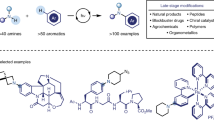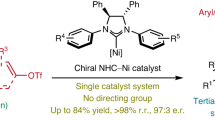Abstract
Fluorine is a key element present in ~35% of agrochemicals and 25% of marketed pharmaceutical drugs. The availability of reliable synthetic protocols to prepare catalysts that allow the efficient incorporation of fluorine in organic molecules is therefore essential for broad applicability. Herein, we report a protocol for the multigram synthesis of two representative enantiopure N-alkyl bis-urea organocatalysts derived from (S)-(–)-1,1′-binaphthyl-2,2′-diamine ((S)-BINAM). These tridentate hydrogen bond donors are highly effective phase-transfer catalysts for solubilizing safe and inexpensive metal alkali fluorides (KF and CsF) in organic solvents for enantioselective nucleophilic fluorinations. The first catalyst, characterized by N-isopropyl substitution, was obtained by using a two-step sequence consisting of reductive amination followed by urea coupling from commercially available starting materials (14 g, 48% yield and 5-d total synthesis time). The second catalyst, featuring N-ethyl alkylation and meta-terphenyl substituents, was accessed via a novel, scalable, convergent route that concluded with the coupling between N-ethylated (S)-BINAM and a preformed isocyanate (52 g and 52% overall yield). On this scale, the synthesis requires ~10 d. This can be reduced to 5 d by performing some steps in parallel. Compared to the previous synthetic route, this protocol avoids the final chromatographic purification and produces the desired catalysts in very high purity and improved yield.
This is a preview of subscription content, access via your institution
Access options
Access Nature and 54 other Nature Portfolio journals
Get Nature+, our best-value online-access subscription
$29.99 / 30 days
cancel any time
Subscribe to this journal
Receive 12 print issues and online access
$259.00 per year
only $21.58 per issue
Buy this article
- Purchase on Springer Link
- Instant access to full article PDF
Prices may be subject to local taxes which are calculated during checkout












Similar content being viewed by others
Data availability
The authors declare that additional data related to this protocol are available in the key references using this protocol (see ‘Related links’). Analytical data for all compounds described in the Procedure are included directly within this paper.
References
Pihko, P. M., ed. Hydrogen Bonding in Organic Synthesis (Wiley-VCH, 2009).
Taylor, M. S. & Jacobsen, E. N. Asymmetric catalysis by chiral hydrogen-bond donors. Angew. Chem. Int. Ed. Engl. 45, 1520–1543 (2006).
Doyle, A. G. & Jacobsen, E. N. Small-molecule H-bond donors in asymmetric catalysis. Chem. Rev. 107, 5713–5743 (2007).
Brak, K. & Jacobsen, E. N. Asymmetric ion-pairing catalysis. Angew. Chem. Int. Ed. Engl. 52, 534–561 (2013).
Ford, D. D., Lehnherr, D., Kennedy, C. R. & Jacobsen, E. N. Anion-abstraction catalysis: the cooperative mechanism of α-chloroether activation by dual hydrogen-bond donors. ACS Catal. 6, 4616–4620 (2016).
Pfeifer, L. et al. Hydrogen-bonded homolopetic fluoride-diarylurea complexes: structure, reactivity and coordinating power. J. Am. Chem. Soc. 138, 13314–13325 (2016).
Zhou, Y., Zhang, J. F. & Yoon, J. Fluorescence and colorimetric chemosensors for fluoride-ion detection. Chem. Rev. 114, 5511–5571 (2014).
Pupo, G. et al. Asymmetric nucleophilic fluorination under hydrogen bonding phase-transfer catalysis. Science 360, 368–642 (2018).
Pupo, G. et al. Hydrogen bonding phase-transfer catalysis with potassium fluoride: enantioselective synthesis of β-fluoroamines. J. Am. Chem. Soc. 141, 2878–2883 (2019).
Roagna, G. et al. Hydrogen bonding phase-transfer catalysis with ionic reactants: enantioselective synthesis of γ-fluoroamines. J. Am. Chem. Soc. 142, 14045–14051 (2020).
Harsanyi, A. & Sandford, G. Organofluorine chemistry: applications, sources and sustainability. Green. Chem. 17, 2081–2086 (2015).
Ibba, F. et al. Impact of multiple hydrogen bonds with fluoride on catalysis: insight from NMR spectroscopy. J. Am. Chem. Soc. 142, 19731–19744 (2020).
Kim, K. H., Lee, D.-W., Lee, Y.-S., Ko, D.-H. & Ha, D.-C. Enantioselective oxidative coupling of methyl-3-hydroxy-2-naphthoate using mono-N-alkylatedoctahydrobinaphthyl-2,20-diamine ligand. Tetrahedron 60, 9037–9042 (2004).
Cotarca, L., Geller, T. & Répási, J. Bis(trichloromethyl)carbonate (BTC, triphosgene): a safer alternative to phosgene? Org. Process Res. Dev. 21, 1439–1446 (2017).
Acknowledgements
This work was supported by the EU Horizon 2020 Research and Innovation Programme (Marie Sklodowska-Curie agreement 675071 and 789553), the Engineering and Physical Sciences Research Council (EP/R010064) and the European Research Council (Agreement 832994).
Author information
Authors and Affiliations
Contributions
All authors contributed to the design and development of these catalysts. G.P. and F.I. developed the first synthesis of this class of catalysts, and A.C.V. has modified the process for scale-up. V.G. conceived and directed the project. All authors contributed to drafting and commenting on the manuscript.
Corresponding author
Ethics declarations
Competing interests
The authors declare no competing interests.
Additional information
Peer review information Nature Protocols thanks Ryan Gilmour, Xi-Sheng Wang and the other, anonymous, reviewer(s) for their contribution to the peer review of this work.
Publisher’s note Springer Nature remains neutral with regard to jurisdictional claims in published maps and institutional affiliations.
Related links
Key references using this protocol
Pupo, G. et al. Science 360, 638–642 (2018): https://doi.org/10.1126/science.aar7941
Pupo, G. et al. J. Am. Chem. Soc. 141, 2878–2883 (2019): https://doi.org/10.1021/jacs.8b12568
Roagna, G. et al. J. Am. Chem. Soc. 142, 14045–14051 (2020): https://doi.org/10.1021/jacs.0c05131
Rights and permissions
About this article
Cite this article
Vicini, A.C., Pupo, G., Ibba, F. et al. Multigram synthesis of N-alkyl bis-ureas for asymmetric hydrogen bonding phase-transfer catalysis. Nat Protoc 16, 5559–5591 (2021). https://doi.org/10.1038/s41596-021-00625-y
Received:
Accepted:
Published:
Issue Date:
DOI: https://doi.org/10.1038/s41596-021-00625-y
Comments
By submitting a comment you agree to abide by our Terms and Community Guidelines. If you find something abusive or that does not comply with our terms or guidelines please flag it as inappropriate.



